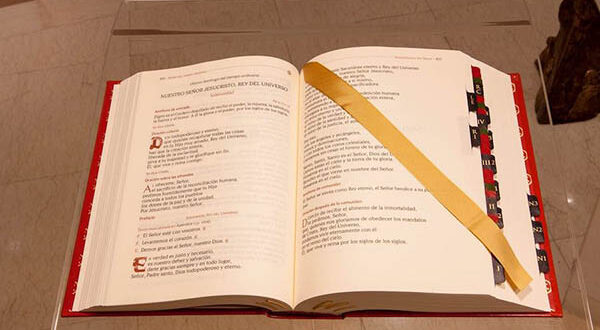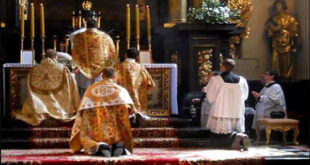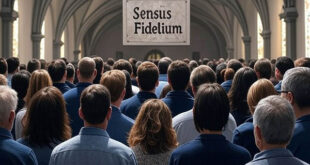The Eucharist is the center of Christian life, the act in which, as a Church, we celebrate and renew the mystery of salvation. At the heart of this celebration is one of the most important and ancient resources in the Church: the Roman Missal. Often, its depth and richness go unnoticed by many. Today, we will explore its history, meaning, and how we can apply its contents and teachings to our everyday lives, inspiring us to live our faith more fully and consciously.
1. What is the Roman Missal?
The Roman Missal is the liturgical book that contains all the texts, prayers, and readings necessary to celebrate Mass throughout the year in the Catholic Church. Every prayer, rite, and gesture is meticulously arranged, uniting the Church in a single voice and action of faith. This book is not just a manual for the priest but serves as the heart of liturgical life, providing all the faithful with a structure for experiencing each Eucharistic celebration with unity and profound meaning.
2. History of the Roman Missal
To understand the value of the Roman Missal, it’s essential to explore its history and evolution. From the early centuries of Christianity, the celebration of the Mass developed, retaining its essence but adjusting to the needs of each era. In early Christianity, the prayers and readings were not compiled in a single volume. However, over time, these texts were gathered into a single book, known as the “sacramentary,” which contained the prayers of consecration and other key liturgical elements.
It was at the Council of Trent (1545-1563) that an effort to unify liturgical celebrations was established, and in 1570, Pope Pius V promoted the first formal Roman Missal, standardizing the celebration of the Mass throughout the Church in the Latin rite. This missal was not only an attempt to establish consistency but also a way to preserve doctrine and apostolic tradition during a time of division and change within the Church.
The Roman Missal has undergone several revisions since then, with the most significant taking place after the Second Vatican Council (1962-1965). This council called for greater participation by the faithful in the Mass, prompting a modernization of the Missal’s structure to make it more accessible and understandable to the people. The latest edition, known as the Third Typical Edition, was published in Latin in 2002 and has since been translated into many languages.
3. Structure and Content of the Roman Missal
The Roman Missal is organized to help us experience the Liturgical Year in a structured and meaningful way. It covers the Advent, Christmas, Lent, Easter, and Ordinary Time seasons, as well as special celebrations for saints and important feast days.
The structure of the Missal includes:
- The Order of the Mass: the prayers and gestures repeated in each Mass, such as the Penitential Act, the Creed, the Our Father, and the Consecration.
- The Proper of Seasons: texts and readings specific to each liturgical season.
- The Proper of Saints: prayers and readings for the feast days of saints throughout the year.
- Common Masses: texts applicable to various types of celebrations, such as Masses in honor of the Virgin Mary, martyrs, or saints who are Doctors of the Church.
- Masses and Prayers for Various Needs: offer intentions and petitions for specific moments in the life of the Church and the faithful, such as Masses for peace, for the deceased, or for the sick.
4. Theological Significance of the Roman Missal
The Roman Missal is not merely a book of prayers; it reflects the Catholic doctrine and spiritual richness of the Church. Each prayer and rite results from centuries of tradition, theology, and pastoral experience.
a) Unity of the Church
The Roman Missal unites us in a common prayer and celebration with all Catholics worldwide. This reflects the mystery of the Church as the Body of Christ, which, though composed of many parts, is one in Christ. When we use the same Missal, each Mass becomes a universal celebration and a bond between all believers, regardless of culture, language, or location.
b) Real Presence and the Eucharist
The Roman Missal focuses our prayers on the real presence of Christ in the Eucharist. The text guides us through the rite of consecration and communion, and every word emphasizes the mystery of transubstantiation, in which the bread and wine become the Body and Blood of Christ. Thus, the Missal invites us into a living and intimate communion with God.
c) Conversion and Christian Commitment
The various prayers and rites of the Missal are designed to lead us in a process of conversion and commitment. For example, the Penitential Act invites us to recognize our weakness and ask for forgiveness, while the Sign of Peace reminds us of our mission to build peace and reconciliation in the world.
5. Practical Application: How to Integrate the Roman Missal in Our Daily Lives
Although the Roman Missal is formally used during Mass, it can have a much closer and practical presence in the daily lives of each Catholic. Here are some ways its content and spirituality can inspire and transform us every day:
a) Rediscovering the Meaning of Liturgy
Reading and understanding the texts of the Roman Missal before Mass can help us participate more fully in the liturgy. Knowing the readings and prayers in advance can deepen our disposition, making our responses more intentional. This transforms our experience of Mass into a personal and communal encounter with God.
b) Daily Examination of Conscience
The Roman Missal, in the section of the Penitential Act, reminds us of the importance of conversion and repentance. Taking a few minutes each night to review our day, thanking God for blessings and asking forgiveness for our shortcomings, is a practice that strengthens our spiritual life.
c) Praying with the Saints
The Proper of Saints section in the Roman Missal contains specific prayers for each saint. Honoring the saints and praying with them allows us not only to follow their example but also to ask for their intercession as we face life’s challenges. Praying with the saints and learning from their virtues can bring us closer to a stronger and more committed life of faith.
d) Celebrating the Liturgical Year at Home
Each liturgical season has special meaning. For example, in Advent, we can use the Roman Missal to prepare actively for Christmas, dedicating time for prayer and family reflection. During Lent, we can commit to a sacrifice or act of charity, accompanied by the Missal’s prayers.
e) Living a Conscious and Participative Faith
The Roman Missal invites us to live our faith with intention and participation. It helps us realize that our faith journey is not limited to Sundays but is a daily commitment to seeking God in all that we do. This calls us to build a spirituality reflected in our decisions, our relationships, and our way of seeing the world.
6. Inspiration and Guidance for the Modern Catholic
In a world where we often feel divided and disconnected, the Roman Missal offers us a way to connect our daily lives with our faith. This book is not just an ancient collection of rituals but an invitation to live in communion with the universal Church, to celebrate our faith with joy, and to seek God in every aspect of our existence.
By understanding the Roman Missal and applying its spirituality in our lives, we discover a richness that inspires us to live with a deeper purpose, to love God and our neighbor in concrete ways, and to draw closer each day to the mystery of the Eucharist, in which Christ is made present for us. May the Roman Missal be a guide and a source of spiritual strength, leading us to a more conscious, active, and fulfilling faith in which every day, every action, and every word reflect our love and commitment to God and to the Church.






